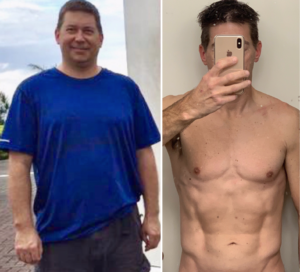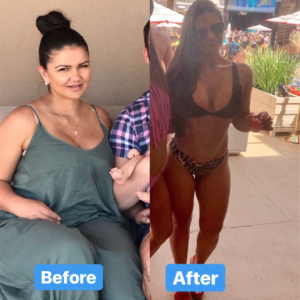It exists.
I’m talking about the holy grail of weight loss.
And it’s actually a lot simple than you think.
What is OMAD Keto?
Eating one meal a day (OMAD Diet), a form of intermittent fasting, and the keto diet are two things that I talk about a lot.
And for good reason.
Both claim to provide an impressive list of health benefits well beyond weight loss. But can you follow both eating plans at the same time?
Abso-freaking-lutely!
Not only are these two eating plans compatible, but they actually enhance one another. Not losing weight on the keto diet? Or maybe you’ve just hit a weight loss plateau, period? Not losing weight with intermittent fasting? Maybe you’re looking for a way to make intermittent fasting more manageable.
If you answered ‘yes’ to any of those questions, then going OMAD Keto is definitely the answer. I’m even gonna go as far as saying that OMAD Keto IS the holy grail of weight loss.
Don’t believe me? Here’s one of my private coaching clients who got insane results by following the OMAD Keto diet.

Here’s another Keto one meal a day success story.

Want to know more? In this video, I talk about why you should combine intermittent fasting and the keto diet.
What is a Ketogenic Diet?
First, let’s do a quick review on what exactly the Keto diet is.
A keto diet in it’s very essence is a very low carb, high fat, and moderate protein diet. In terms of macronutrient percentages, you wanna go around at least 70% fat and even as high as 80%, 15 to 20% protein, and around 5% carbs.
But the most important number here is the amount of carbs in your diet. You wanna limit your carb intake to 40 to 50 grams per day when you’re starting out. And even as low as 20 to 30 grams depending on your carb tolerance.
So, what happens when you limit your carb intake and give your body mainly fat to burn, it adapts to become very good at using fat for energy.
Your brain, which was previously running entirely on glucose from the carbs that you eat begins running entirely on a new fuel called ketones.
That’s where the name “Ketogenic” comes from. Our liver makes all the energy we need when we don’t eat carbs from fatty acids and ketones. We generate any glucose the body needs through a process called Gluconeogenesis. Sounds fancy, I know.
As long as you limit your carbs, you eat moderate protein, and you eat a diet high in fat, in 2 to 6 weeks you become keto adapted and then you’re running on mostly fat for energy. That is, dietary fat and body fat. You become a fat burner. And yes, you need to eat fat in order to burn fat. No, eating fat won’t make you fat.
Combing Keto with intermittent fasting
But one of the most important things that you need to know about combining ketogenic diet and intermittent fasting is that it’s the only diet that will drastically reduce insulin.
If you think about the underlying cause of metabolic sydrome, which is hyper insulinemia, or too much insulin, the side effects which are weight gain, cravings for sugar, feeling hungry all the time, difficulty concentrating, feeling anxious or panicky, lacking focus or motivation, and fatigue, the keto diet fasting falls much closer to a diet that will solve this problem.
So how exactly does intermittent fasting and the keto fasting diet benefit one another?
The benefits of the Keto OMAD Diet
1. You shift into ketosis faster
One of the primary goals of a keto diet fasting is to get into a state of nutritional ketosis. And you do this again by restricting carbs.
When you do intermittent fasting keto, you deplete your body of glycogen stores because that’s what gets used up first. Once your glycogen stores are gone, fat stores are released into your bloodstream to be converted into ketones and you enter a state of? You know it. Ketosis.
So if you combine intermittent fasting keto which puts you in a state of ketosis, to a diet that puts you in a state of nutritional ketosis, the keto diet fasting, then you become an unbelievably efficient fat burning machine. Which is actually benefit number two.
2. It maximizes your weight loss
The common idea that intermittent fasting and the keto diet share is they’re designed to switch your body from being a sugar burner to a fat burner. And when you put both eating plans together, your fat burning is maximized.
Here’s why. Once your body enters a state of nutritional ketosis through the keto diet, then your body has adapted itself to using fat as fuel. Right?
When you add intermittent fasting into the mix, your body is already fat adapted and will actually be even more efficient at continuing to burn fat. You just keep burning your body fat after your body is done digesting your ketogenic meal.
Compare this to someone who follows the standard American diet of high carbs and low fat. If they do intermittent fasting, their body will be much less efficient at burning fat because it doesn’t really get a chance to get into nutritional ketosis.
If you keep eating carbs, your body will always prefer to use that up first. Your insulin also gets elevated when you eat a high carb diet which blocks fat burning. That’s why some people don’t get good results with IF. Now I’m not saying you can’t get good results from intermittent fasting if you follow a high carb low fat diet. Some people do. It really depends on your metabolic flexibility.
3. It boosts your brain health and it increases mental clarity
Your brain is one of your body’s biggest consumers of energy.
And fat, not sugar, which is what companies like coke and gatorade want you to believe, is the most energy-efficient fuel that your body can run on. Since both intermittent fasting and the keto diet fasting train your body to burn fat for energy, your brain reaps huge benefits if you combine the two.
After all, unless you’re at about 4% body fat, we always have fat stores available to burn. You have about 40,000 calories worth of stored energy in your body in the form of body fat. It’s not just there for looks. So as long as your body knows how to tap into those fat stores for fuel, your brain has a constant and efficient energy source on which to run.
4. It makes both diets easier to follow
One of the biggest drawbacks some people experience when they start combining intermittent fasting and the keto diet is that they get hunger pangs and some people even experience headaches and fatigue. And then they say that it doesn’t work for them.
But here’s the thing. If you’ve been following the standard American diet of eating lots of refined carbs and sugar and then all of a sudden, you start going OMAD keto. Getting headaches, hunger pangs, and fatigue is just your body’s natural reaction to the change you’re putting it through. There’s an adaptation period there. You can’t just flip a switch.
You have to give it some time. Those symptoms are usually caused by your body going through carb withdrawal.
That’s why I recommend doing a keto diet first. Then slowly start transitioning to an intermittent fasting lifestyle by eating one meal a day once your body is fat adapted.
It’s a lot easier to fast if your body is fully satiated from all the fat you just ate from your last meal. Both eating plans are also designed to keep your insulin levels steady. Which means less cravings and hunger pangs over the long term which makes it a very sustainable plan you can follow.
As always, if this was helpful, share it with a friend who could benefit from it as well!

Need More Help?
Use this simple 4-step process to melt ALL the fat around your stomach and look good shirtless WITHOUT going on a crazy diet or wasting hours at the gym. Get the Lean Body Blueprint here for free!
My experience on Keto was it helped me MAINTAIN my weight, but it was only when I went to OMAD and began long(4+ hour) wlaks that I started dropping the kilos.
Keto is great for reducing insulin spikes, but at the end of the day, its still how many calories you eat.